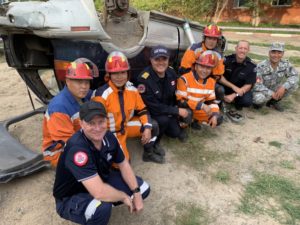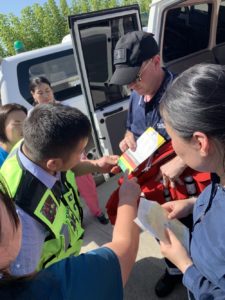Research by a Griffith University team led by Dr Hamish McLean is changing the way Mongolia deals with medical emergencies.
Dr McLean’s team, including Clinical Director Duncan McConnell and colleagues from Canada, has been officially recognised by the Mongolian Society for Emergency Medicine for its evidence-based input into steering Mongolia toward a sustainable emergency medical service (EMS) after two weeks of training workshops and high-level meetings with government officials. This is the third phase of a project which started in 2017.
Dr McLean, a senior lecturer in the School of Humanities, Languages and Social Science, and his colleagues are preparing a series of recommendations for the Ministry of Health and the World Health Organisation to help emergency agencies in Mongolia deliver coordinated medical roadside responses.

Griffith University Mongolia project clinical director Duncan McConnell with Canadian EMS colleagues and Mongolian firefighters following a car accident exercise.
“We are helping Mongolia develop an EMS system, with the support of its firefighters, military and police, based on evidence that it is sustainable and works for the country’s context and resources,” he said.
“Any imported system from Australia, the US or Canada would simply collapse due to costs and lack of resources.
“Our challenge is to find a way that works in improving treatment and response times within current resources.”
Griffith Centre for Environment and Population Health PhD student Mr McConnell is working on a model that is unique for Mongolia based on first-hand experience at the front line.

Mr McConnell explains the triage system to a Mongolian ambulance doctor.
Mr McConnell, a paramedic with 23 years’ experience, joined British Columbia Ambulance Service director Joe Acker and Vancouver Fire and Rescue Department Chief Darrell Reid on the road with Mongolian ambulance doctors.
The team observed fatal heart attacks, roadside trauma with head injuries and crying babies – just as an ambulance crew in Australia would.
The only difference is the Mongolian ambulance is staffed by a newly-graduated doctor with very limited equipment.
“The evidence of co-operation between agencies was demonstrated between Australia and Canada, both with different systems, and this has inspired Mongolia to do the same between ambulance services, firefighters, military and police,” Dr McLean said.
“What this delivers is medical assistance quickly rather than Mongolians in the capital city of 1.4 million people waiting for up to an hour for an ambulance.
“The ambulance doctors do a fantastic job considering all the challenges.”
